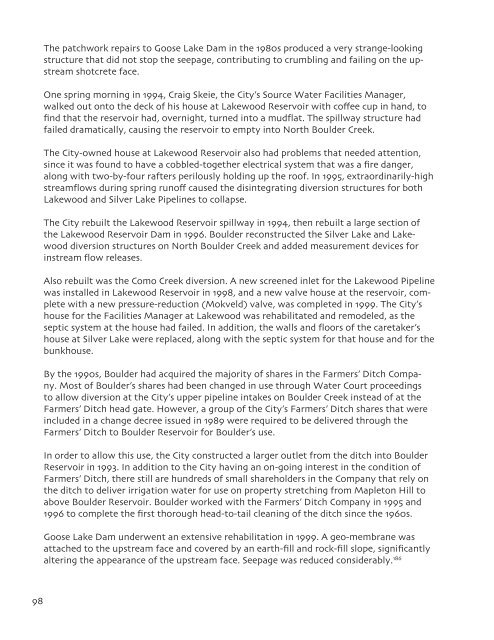Create successful ePaper yourself
Turn your PDF publications into a flip-book with our unique Google optimized e-Paper software.
The patchwork repairs to Goose Lake Dam in the 1980s produced a very strange-looking<br />
structure that did not stop the seepage, contributing to crumbling and failing on the upstream<br />
shotcrete face.<br />
One spring morning in 1994, Craig Skeie, the City’s Source Water Facilities Manager,<br />
walked out onto the deck of his house at Lakewood Reservoir with coffee cup in hand, to<br />
find that the reservoir had, overnight, turned into a mudflat. The spillway structure had<br />
failed dramatically, causing the reservoir to empty into North Boulder Creek.<br />
The City-owned house at Lakewood Reservoir also had problems that needed attention,<br />
since it was found to have a cobbled-together electrical system that was a fire danger,<br />
along with two-by-four rafters perilously holding up the roof. In 1995, extraordinarily-high<br />
streamflows during spring runoff caused the disintegrating diversion structures for both<br />
Lakewood and Silver Lake Pipelines to collapse.<br />
The City rebuilt the Lakewood Reservoir spillway in 1994, then rebuilt a large section of<br />
the Lakewood Reservoir Dam in 1996. Boulder reconstructed the Silver Lake and Lakewood<br />
diversion structures on North Boulder Creek and added measurement devices for<br />
instream flow releases.<br />
Also rebuilt was the Como Creek diversion. A new screened inlet for the Lakewood Pipeline<br />
was installed in Lakewood Reservoir in 1998, and a new valve house at the reservoir, complete<br />
with a new pressure-reduction (Mokveld) valve, was completed in 1999. The City’s<br />
house for the Facilities Manager at Lakewood was rehabilitated and remodeled, as the<br />
septic system at the house had failed. In addition, the walls and floors of the caretaker’s<br />
house at Silver Lake were replaced, along with the septic system for that house and for the<br />
bunkhouse.<br />
By the 1990s, Boulder had acquired the majority of shares in the Farmers’ Ditch Company.<br />
Most of Boulder’s shares had been changed in use through Water Court proceedings<br />
to allow diversion at the City’s upper pipeline intakes on Boulder Creek instead of at the<br />
Farmers’ Ditch head gate. However, a group of the City’s Farmers’ Ditch shares that were<br />
included in a change decree issued in 1989 were required to be delivered through the<br />
Farmers’ Ditch to Boulder Reservoir for Boulder’s use.<br />
In order to allow this use, the City constructed a larger outlet from the ditch into Boulder<br />
Reservoir in 1993. In addition to the City having an on-going interest in the condition of<br />
Farmers’ Ditch, there still are hundreds of small shareholders in the Company that rely on<br />
the ditch to deliver irrigation water for use on property stretching from Mapleton Hill to<br />
above Boulder Reservoir. Boulder worked with the Farmers’ Ditch Company in 1995 and<br />
1996 to complete the first thorough head-to-tail cleaning of the ditch since the 1960s.<br />
Goose Lake Dam underwent an extensive rehabilitation in 1999. A geo-membrane was<br />
attached to the upstream face and covered by an earth-fill and rock-fill slope, significantly<br />
altering the appearance of the upstream face. Seepage was reduced considerably. 186<br />
98



